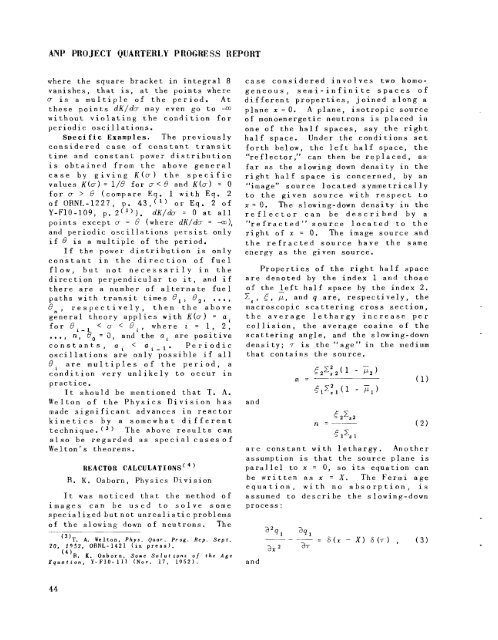the Molten Salt Energy Technologies Web Site
the Molten Salt Energy Technologies Web Site
the Molten Salt Energy Technologies Web Site
You also want an ePaper? Increase the reach of your titles
YUMPU automatically turns print PDFs into web optimized ePapers that Google loves.
ANP PROJECT QUARTERLY PROGRESS REPORT<br />
where <strong>the</strong> square bracket in integral 8<br />
vanishes, that is, at <strong>the</strong> points where<br />
0 is a multiple of <strong>the</strong> period. At<br />
<strong>the</strong>se points dK/du may even go to 4<br />
without violating <strong>the</strong> condition for<br />
periodic oscillations.<br />
Specific Examples. The previously<br />
considered case of constant transit<br />
time and constant power distribution<br />
is obtained from <strong>the</strong> above general<br />
case by giving K(D) <strong>the</strong> specific<br />
values K(D) = 1/B for D< 0 and K(G) = 0<br />
for 0 > 6 (compare Eq. 1 with Eq. 2<br />
of ORNL-1227, p. 43,(’) or Eg. 2 of<br />
Y-F10-109, p. 2(’)), dK/h = 0 at all<br />
points except cr = 0 (where dK/do = a),<br />
and periodic oscillations persist only<br />
if 6 is a multiple of <strong>the</strong> period,<br />
If <strong>the</strong> power distribution is only<br />
constant in <strong>the</strong> direction of fuel<br />
flow, but not necessarily in <strong>the</strong><br />
direction perpendicular to it, and if<br />
<strong>the</strong>re are a number of alternate fuel<br />
paths with transit times 0,, e,, ...,<br />
@ respectively, <strong>the</strong>n <strong>the</strong> above<br />
n ’<br />
general <strong>the</strong>ory applies with K(o) = ai<br />
for B1-, < o < ol, where L = 1, 2,<br />
... , n, 8, = 0, and <strong>the</strong> az are positive<br />
constants, a, Periodic<br />
oscillations are only possible if all<br />
0 are multiples of <strong>the</strong> period, a<br />
cAndition very unlikely to occur in<br />
practice.<br />
It should be mentioned that T. A.<br />
Welton of <strong>the</strong> Physics Division has<br />
made significant advances in reactor<br />
kinetics by a somewhat different<br />
technique.(3) The above results can<br />
also be regarded as specialcasesof<br />
We1 ton’s <strong>the</strong>orems,<br />
REACTOR CALCULATPONS( )<br />
R. K. Osborn, Physics Division<br />
It was noticed that <strong>the</strong> method of<br />
images can be used to solve some<br />
specialized butnot unrealistic problems<br />
of <strong>the</strong> slowing down of neutrons. The<br />
(3)T. A. Welton, Phys. Quar. Prog. Rep. Sept.<br />
20, 1952. ORNL-1421 (in press).<br />
(4)B. K. Osborn, Sore Solutions of <strong>the</strong> Age<br />
Equation, Y-F10- 111 (Nov. 17, 1952).<br />
44<br />
case considered involves two homo-<br />
geneous, semi-infinite spaces of<br />
different properties, joined along a<br />
plane x = 0. A plane, isotropic source<br />
of monoenergetic neutrons is placed in<br />
one of t,he half spaces, say <strong>the</strong> right<br />
half space. IJnder <strong>the</strong> conditions set<br />
forth below, <strong>the</strong> left half space, <strong>the</strong><br />
“reflector,” can <strong>the</strong>n be replaced, as<br />
far as <strong>the</strong> slowing down density in <strong>the</strong><br />
right half space is concerned, by an<br />
I1<br />
image” source located symmetrically<br />
to <strong>the</strong> given source with respect to<br />
x = 8. The slowing-down density in <strong>the</strong><br />
reflector can be described by a<br />
“refracted” source located to <strong>the</strong><br />
right of I: = 0. The image source and<br />
<strong>the</strong> refracted source have <strong>the</strong> same<br />
energy as <strong>the</strong> given source.<br />
Properties of <strong>the</strong> right half space<br />
are denoted by <strong>the</strong> index 1 and those<br />
of <strong>the</strong> left half space by <strong>the</strong> index 2.<br />
Is, 5, E, and q are, respectively, <strong>the</strong><br />
macroscopic scattering cross section,<br />
<strong>the</strong> average lethargy increase per<br />
collision, <strong>the</strong> average cosine of <strong>the</strong><br />
scattering angle, and <strong>the</strong> slowing-down<br />
density; 7 is <strong>the</strong> “age” in <strong>the</strong> medium<br />
that contains <strong>the</strong> source,<br />
(1)<br />
(2)<br />
are constant with lethargy. Ano<strong>the</strong>r<br />
assumption is that <strong>the</strong> source plane is<br />
parallel to x = 0, so its equation can<br />
be written as x = X. The Fermi age<br />
equation, with no absorption, is<br />
assumed to describe <strong>the</strong> slowing-down<br />
process :<br />
and



![Review of Molten Salt Reactor Physics Calculations [Disc 2]](https://img.yumpu.com/21979492/1/190x247/review-of-molten-salt-reactor-physics-calculations-disc-2.jpg?quality=85)












